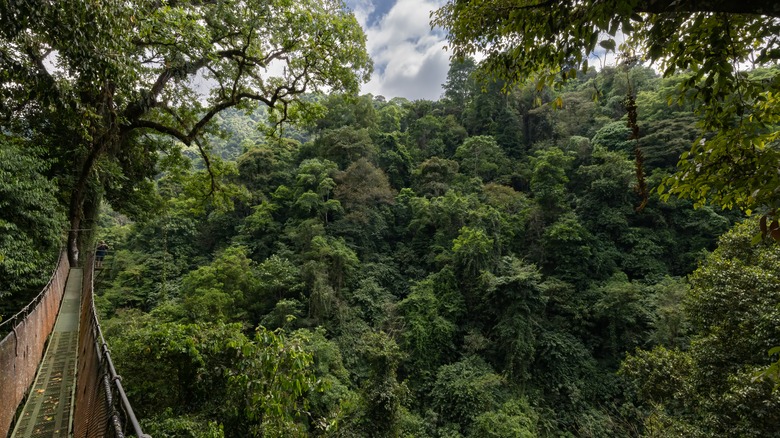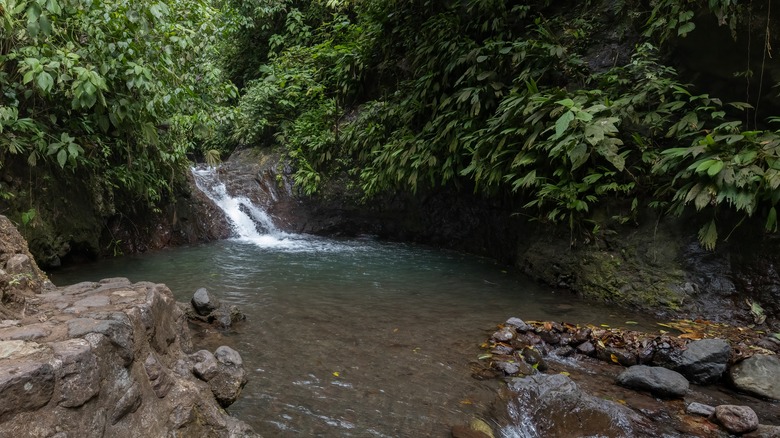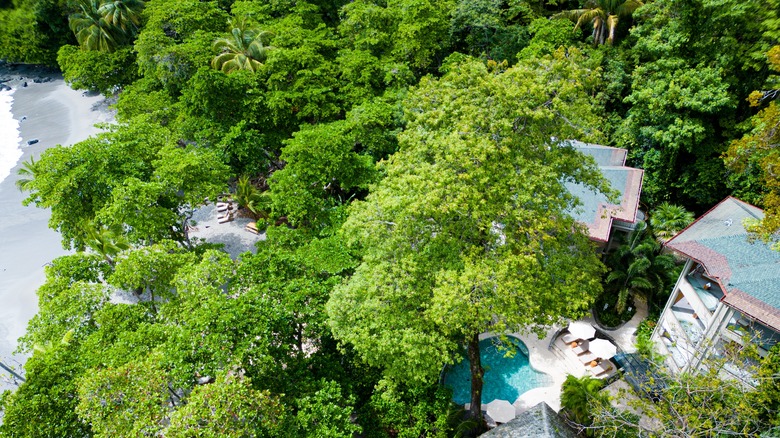Costa Rica Is Home To One Of Central America's 'Most Biologically Diverse Properties' To Explore
Walk on suspension bridges high above the canopy of a dense rainforest and take a refreshing dip in a waterfall deep in "one of the most biologically diverse properties in Central America," according to the website of Rainmaker Conservation Park. A spectacular, under-the-radar private reserve on the Central Pacific coast of Costa Rica in the province of Puntarenas, Rainmaker is near the more famous Manuel Antonio Park. But that doesn't mean you should ignore Rainmaker, which has some incredible jungle you can walk through and 1,500 acres to explore.
Costa Rica is one of the world's most biodiverse places, meaning it has a significant percentage of all the species on Earth in a relatively small area. Rainmaker is 80% virgin rainforest and was established for scientific research, so its many species of flora and fauna are in their natural state, free from human interference. Alive with birds and butterflies, frogs and sloths, Rainmaker is home to 60% of Costa Rica's species. From its observation platforms and hanging bridges you can literally get a bird's eye view over the leafy rainforest. Many avian species like to be high up in trees, so be on the lookout for toucans, trogons, falcons, and hummingbirds. The six suspension bridges are securely attached to sturdy trees and are in accordance with U.S. engineering safety standards. Walking along the treetops is one of the best things to do in Costa Rica for an unforgettable vacation. Back down on the forest floor, waterfalls spill through the lush foliage into pools that beckon hikers.
What's so special about Rainmaker?
Only a half hour from the tourism centers of Manuel Antonio and Quepos, Rainmaker is a lesser-known gem. One of the things that make Rainmaker special is how it's so easily accessible — there's even a restaurant here – yet it's so protected and wild. Of the many species of wildlife, the threatened Blue Morpho butterfly is a standout for its vibrant blue color (but only when seen from above; its wings are brown underneath). Frog lovers especially should flock to Rainmaker, as these amphibians are copious there. This reserve even made headlines when a frog species that was thought extinct — the Costa Rican variable harlequin toad or clown frog — was spotted here. Look for transparent glass frogs near water sources and red-eyed tree frogs climbing through the foliage. Snakes and salamanders, iguanas, and basilisks are prevalent as are a host of colorful birds chattering overhead, like parrots. Rainmaker is also the habitat of mammals like squirrel monkeys and ocelots that are not as easily observed. The park's biodiversity extends to plant life, with stately ceibas and giant fig trees, expansive ferns, and colorful orchids and bromeliads.
The government of Costa Rica has recognized Rainmaker for the protection of three critical ecosystems, its sustainable model of conservation, and its valuable water sources, including springs and aquifers. The reserve is part of the Quepos Biological Corridor, which is one of the country's 44 delineated swathes of land that connect ecosystems and wild habitats to ensure their continued protection.
Where to stay near Rainmaker Park
The area just north of Manuel Antonio National Park, and a bit more than a half hour from Rainmaker Park, is packed with hotels. One of the best in the area is Gaia Hotel & Reserve, a terraced property on a 10-acre reserve of its own that doesn't allow children under 13. Its 22 accommodations range from single rooms to villas; some have their own Jacuzzi or pool, and the resort has a three-tiered infinity pool, restaurant, spa, and cocktail lounge. Another resort in the area, Arenas del Mar Beachfront and Rainforest Resort, hits the high points in its name: It's directly on two beaches and surrounded by 11 acres of rainforest. There are also two pools here, plus two restaurants and a spa. Because the resort is so close to the park and in its own reserve, monkeys might join you for breakfast, or you might spot an iguana or toucan on the path to the beach.
A third great option, Encantada Ocean Cottages, is west of Rainmaker in Esterillos. Seven cottages with a variety of sleeping layouts and amenities surround a pool and are steps from the Pacific Ocean. Some have ocean views and others are nestled in a garden setting. Owned by an American couple, the property has a beachside restaurant and a daily morning yoga class. Staff can arrange surfing lessons, deep-sea fishing expeditions, horseback riding on the beach, and more to make your stay even more magical. If you're on the fence about whether or not you'll be safe on a vacation to Costa Rica, find out the three safest countries in Central America (luckily, Costa Rica is one of them).


